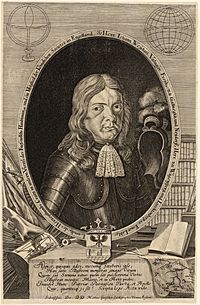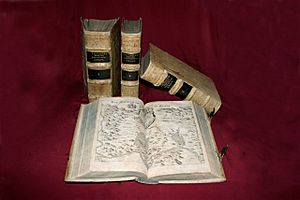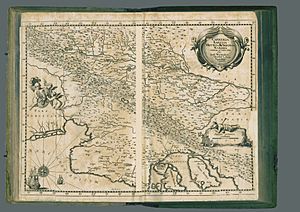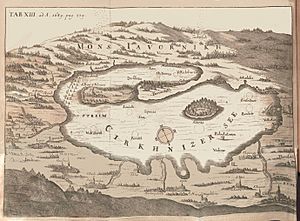Johann Weikhard von Valvasor facts for kids
Quick facts for kids
Johann Weikhard von Valvasor
Janez Vajkard Valvasor |
|
|---|---|

Valvasor in 1689
|
|
| Born | 1641 |
| Died | September or October 1693 (aged 52) Gurkfeld, Carniola, Austria
(now Krško, Slovenia) |
| Known for | nobleman, scholar, polymath |
| Title | Member of the Royal Society |
| Spouse(s) | Anna Rosina Valvasor née Grafenweger |
| Parent(s) | Bartholomäus von Valvasor Anna Maria von Valvasor née Rauber |
Johann Weikhard von Valvasor (born in 1641, died 1693) was a very smart and curious person from a region called Carniola, which is now part of Slovenia. He was like a super-scholar, studying many different things. He was even a member of the Royal Society in London, a famous group of scientists.
He is especially known for being one of the first people to study karst areas. These are places with special landscapes made of limestone, with caves and disappearing rivers. His most famous book, The Glory of the Duchy of Carniola, was a huge collection of information about his home region. It was so important that for a long time, it was the main source for learning about early Slovenian history.
Contents
Biography
Early Life and Family
Valvasor was born in Ljubljana, which was then the main city of the Duchy of Carniola. Today, Ljubljana is the capital of Slovenia. His family was noble and originally came from Italy. In the 1500s, his family moved to Carniola, which was part of the Habsburg monarchy. The name Valvasor means 'carrier of a feud' in old Latin.
We don't know the exact day or place Valvasor was born. But we do know he was baptized in Ljubljana Cathedral. He was the twelfth child of Bartholomäus and Anna Maria. His family lived at Medija Castle and also had a house in Ljubljana.
Education and Travels
Valvasor's father passed away when he was ten, and his mother when he was sixteen. At that time, he was going to a Jesuit school in Ljubljana. He finished school in 1659 when he was seventeen. Instead of going to a university, he decided to travel across Europe to learn from smart people.
His journey lasted fourteen years and even took him to northern Africa. During this time, he joined the army in a war against the Ottoman Empire. This experience helped him learn a lot about the border areas.
Later Life and Work
In 1672, Valvasor married Anna Rosina Grafenweger. Soon after, he bought Bogenšperk Castle near Litija. There, he set up a special workshop for writing, drawing, and printing his books.
Valvasor spent a lot of money publishing his works. Because of this, he got into debt. Towards the end of his life, he had to sell Bogenšperk Castle, his huge library, and his collection of prints. In 1690, a bishop bought his library, which included about 7,300 drawings. This collection became part of a library in Croatia.
In 1692, he lost most of his money after investing in travel, graphics, and books that didn't make a profit. He had nine children with Anna Rosina. Sadly, five of them died very young. Anna Rosina also passed away in 1687 while giving birth to their last child. Just three months later, Valvasor married Anna Maximilla Zetschker. They had four more children together. Valvasor died in 1693 in Krško at the age of 52.
It is thought that he was buried in his family's crypt at Medija Castle. However, this is not certain because the castle was destroyed in 1944.
Legacy
The Glory of the Duchy of Carniola
Valvasor's most important work is called The Glory of the Duchy of Carniola. It was published in 1689. This massive book has 15 parts, over 3,500 pages, and includes 528 pictures and 24 extra sections. It gives a very detailed look at Carniola during his time.
He also wrote the first known document about vampires. He described a legend about a vampire named Jure Grando from a region called Istria. From 2009 to 2012, this huge book was translated into Slovene.
Karst Research
Valvasor was a pioneer in studying karst phenomena. These are unique landscapes formed by water dissolving limestone rock. They often have caves, sinkholes, and rivers that disappear underground.
In 1687, he wrote a detailed paper about the water system of Lake Cerknica. This lake is special because it sometimes disappears and then reappears. His work on this topic was so good that he was made a member of the Royal Society, a very respected scientific group.
Works
- Dominicae passionis icones, 1679
- Topographia Ducatus Carnioliae modernae (Description of Modern Carniola), 1679
- Topographia arcium Lambergianarum (Description of Lamberg Castles), 1679
- Topographia Archiducatus Carinthiae modernae (Description of Modern Carinthia), 1681
- Carniolia, Karstia, Histria et Windorum Marchia, 1681
- Theatrum mortis humanae tripartitum (Theater of Human Death in Three Parts), 1682
- Topographia Archiducatus Carinthiae antiquae & modernae completa (Complete Description of Ancient and Modern Carinthia), 1688
- Opus insignium armorumque (Work of Notable Arms), (1687–1688)
- Die Ehre deß Hertzogthums Crain (The Glory of the Duchy of Carniola), 1689





